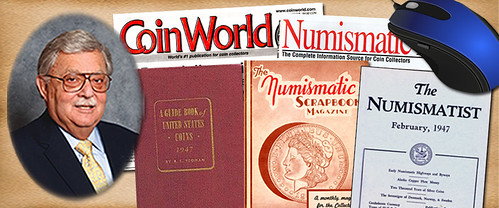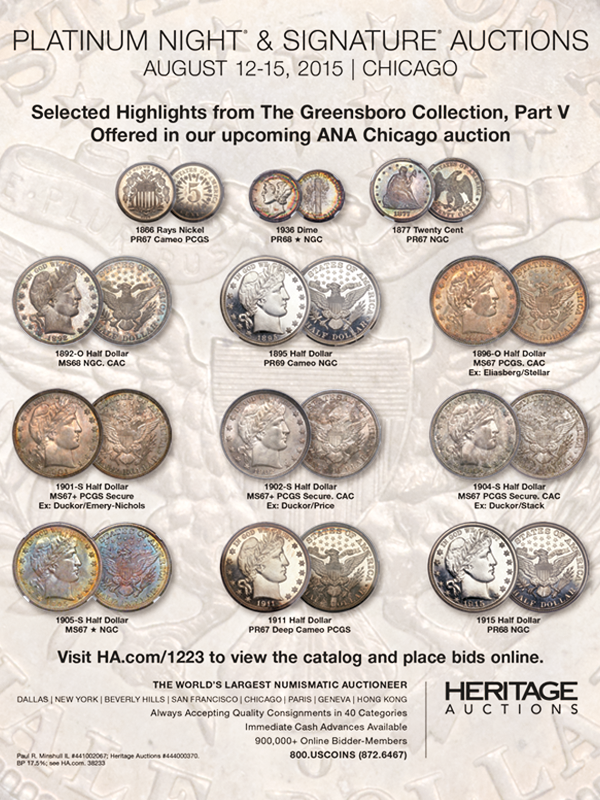
PREV ARTICLE
NEXT ARTICLE
FULL ISSUE
PREV FULL ISSUE
HARVEY STACK ON THE PRINTED WORD IN NUMISMATICS
Are printed books doomed in today's digital age? Harvey Stack is addressing this topic in a series of blog posts on the Stack's
Bowers web site. We looked at the first two installments in July. Here are some excerpts from parts 3 and 4. See the complete versions
online. -Editor

A few weeks ago I started writing about some comments made by David Harper of Numismatic News at the Texas Numismatic Association Show in early June regarding the demise of the printed word in numismatics. When I consider the next 25 years, I agree with many of Dave Harper's predictions, but I will offer some ideas that I think are important to maintain collector interest and keep the hobby viable and exciting As I noted earlier, David Harper’s remarks about the demise of the printed word gave me much to think about. Obviously, the main factor that has caused the printed word to lose favor among coin collectors (as well as other hobbies) is the fast, current information provided by the Internet -- definitely a positive aspect in many regards. However, I hope that David Harper is incorrect when he says that the printed word will be completely supplanted by electronic media. The current world is demanding, requiring immediate news and speedy answers to any questions. In this way electronic media has an edge on the printed word. But do we always need to be informed so quickly? I think not! Sometimes great enjoyment comes from studying, reviewing and finding the answers to questions, not necessarily just having the information immediately provided. Many of the great collectors I have known were not in a rush to complete their cabinets. The fine collections I have helped start, build, improve and eventually sell were not accumulated in a hurry. Louis E. Eliasberg spent many years building his monumental collection and continued to collect until he passed away in 1976. He enjoyed owning and displaying the collection. Josiah K. Lilly, whose collection is one of the feature collections housed in the Smithsonian Institution, started collecting in 1951 and the coins were given to the Smithsonian only after his death in 1967. Even the D. Brent Pogue Collection that Stack’s Bowers Galleries is auctioning now in the 21st century, was carefully and diligently collected over 40 years. Devoting time to building a fine collection is an essential part of the process. I have heard this phrase said often and like to repeat it to myself: "A collection [of anything, in this case coins] is not a necessity of life, you do not have to wear it, eat it or live in it,” so there is no reason to rush. The electronic world has changed the way things are happening, but I still feel it is not the only tool needed to be a collector. Perspective can be gained by reviewing the past and comparing it to the present. While more and more information is available on the Internet (if one knows how and where to look), there is much that is not. Actual printed documents offer readers the ease of reviewing and making notes. I find that information found on the Internet is often printed out, thus becoming the “printed word.” And, there is something special about a book or magazine that you can hold in your hand. Reading books, auction catalogs and pricelists in a quiet relaxed setting can be a pleasurable experience as well as a way to get information. Even the pdf catalogs available at StacksBowers.com speak to the desire of our customers to view auction lots in the context of the other coins in a sale. The content of books is surely not all reproduced electronically, even though more and more is available as each day passes. I congratulate the ESYLUM, published by the Numismatic Bibliomania Society, for its efforts to electronically provide listings of reference books and contents for collectors in the future who are unable to find the information desired. But, it will take a long time, if ever, before everything is available on line. Maybe in the future there will be no need for the printed word. But until that time, enjoy the printed auction catalogs produced by the major auction companies, read the books published by the Whitman Publishing Company, read articles in The Numismatist and other weekly and monthly publications, as well as those put out by various specialized numismatic societies. When you can, attend a lecture or presentation by an accomplished author and researcher. I believe that all of these are worthwhile tools for numismatists, just as electronic information is a useful tool. Numismatic toolboxes can include many things, all of which combine to increase your enjoyment of our great hobby. The electronic world is here to stay, but I hope that David Harper’s predictions do not come true. It is my wish that printed publications will continue to be produced and enjoyed well beyond the next quarter of a century.
While many products are quickly relegated to the past by new technologies (think buggy-whips and Trip-Tiks), new technologies rarely
completely supplant the old; movies didn't kill the theatre, and television didn’t kill radio. Instead, they morphed to fill a niche
still desired by users. While The Internet may kill the printed newspaper, it won't kill journalism, and while printed books are
waning, I doubt they'll ever die. As Harvey notes, there is something special about a book that you can hold in your hand and
continue to use without a fancy device or a steady supply of electricity. Studies are showing that many young people do indeed prefer
hardcopy books, and while bloodied, the industry is still alive and well. Long live the Book! -Editor
Harvey adds: I have always felt, maybe because I am old and depend on my own habits that have ruled me, there is something personal about reading printed copy and being able to have it in front of you, and using the information as it is needed. A printed word has great longevity and handiness that is not easily studied on the internet. The internet is great as a POINTER to where something can be found, but if you needed something as simple as a number of pieces struck in one year, you would have to take a search engine to help you find it , when you could readily pick up a Guide Book to find the information by just turning a few pages. Yup, I am old fashioned, not fully trained in internet devices and methodology, but I am a happy Numismatist, and feel that the Printed Word has more efficiency at times then the electronic world. To read the complete articles, see:
To read the earlier E-Sylum article, see:

Wayne Homren, Editor The Numismatic Bibliomania Society is a non-profit organization promoting numismatic literature. See our web site at coinbooks.org. To submit items for publication in The E-Sylum, write to the Editor at this address: whomren@gmail.com To subscribe go to: https://my.binhost.com/lists/listinfo/esylum All Rights Reserved. NBS Home Page Contact the NBS webmaster 
|